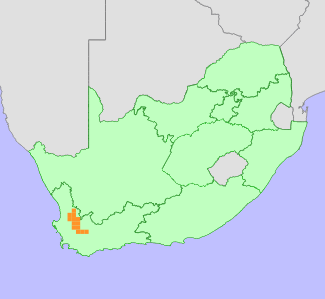|
Scientific Name | Leucospermum catherinae Compton |
Higher Classification | Dicotyledons |
Family | PROTEACEAE |
Common Names | Catherine-wheel Pincushion (e), Speldekussing (a), Waterluisie (a), Wheel Flower (e) |
National Status |
Status and Criteria | Vulnerable C2a(i) |
Assessment Date | 2020/05/24 |
Assessor(s) | A.G. Rebelo, D. Raimondo & L. von Staden |
Justification | Leucospermum catherinae is a naturally-fragmented species associated with seeps and water courses that is endemic to the arid mountains of the Western Cape. This species is known from 31 subpopulations and has an extent of occurrence (EOO) of 4958 km² and area of occupancy (AOO) of 264 km². All subpopulations are small, the majority have fewer than 50 plants, and while a handful of subpopulations have been recorded to number a couple of hundred mature individuals, there is no subpopulation with more than 1000 individuals. The total population known numbers fewer than 6000 mature individuals. This species is experiencing ongoing declines to subpopulations occurring on lower slopes, where it is impacted by crop cultivation and invasive alien plant species. There have also been documented declines at one subpopulation that is most likely the result of incorrect fire regimes coupled with drought conditions impacting recruitment. The ongoing drought conditions across the western parts of South Africa is also suspected to be causing ongoing declines to the population, these declines are likely to be ongoing given climate change predictions for the region. |
Distribution |
Endemism | South African endemic |
Provincial distribution | Western Cape |
Range | This species is known from Cederberg to Hex River Mountains, in the Western Cape, South Africa. |
Habitat and Ecology |
Major system | Terrestrial |
Major habitats | Winterhoek Sandstone Fynbos, Cederberg Sandstone Fynbos, Olifants Sandstone Fynbos, Matjiesfontein Quartzite Fynbos |
Description | It is associated with seeps and river banks in sandstone fynbos. Mature individuals are killed by fires, and only seeds survive. Seeds are released after ripening, and dispersed by ants to their underground nests, where they are protected from predation and fire. It is pollinated by birds. |
Threats |
| Subpopulations occurring on low footslopes of the mountains are threatened by crop cultivation (mainly vineyards) and there are invasive alien plant species threatening subpopulations in the south eastern portion of the range. There has been documented decline as a result of lack of recruitment following fire at the Driehoek subpopulation in the Cedarberg. Most of the subpopulations were monitored between 1995 and 2002 as part of the Protea Atlas Project, the majority have not be resurveyed and it is likely that numbers have recently declined in response to the prolonged drought that has been experienced in the Western Cape between 2015 and 2020. |
Population |
This species occurs as isolated stands of clumped individuals in suitable habitat scattered across its range. A total of 31 subpopulations have been recorded, of which 18 are small and consist of fewer than 50 plants. Other subpopulations never number more than 1000 individuals and typically occur in clumps of between 100 and 300 plants. Only two subpopulations have over 400 individuals.
Although only 11-12% of the occurrence has been lost, about 7 out of 15 historical localities could not be relocated by atlassers, although many new subpopulations were discovered. Two main hypothesis may account for this. Perhaps historically botanists more dependent on water sources effectively encountered L. catherinae more frequently than highly mobile 20th century day trippers. It is also possible that in mature veld, atlassers may have missed adult plants and thus under-recorded the species. Alternatively, increased pressure at wetland sites by agriculturists, herders or groundwater abstraction may have impacted on wetland habitats and reduced population sizes. As a precaution, we currently adopt the latter hypothesis.
|
Population trend | Decreasing |
Assessment History |
Taxon assessed |
Status and Criteria |
Citation/Red List version | | Leucospermum catherinae Compton | EN B1ac(iv)+2ac(iv) | Raimondo et al. (2009) | | Leucospermum catherinae Compton | Not Threatened | Hilton-Taylor (1996) | |
Bibliography |
Goldblatt, P. and Manning, J.C. 2000. Cape Plants: A conspectus of the Cape Flora of South Africa. Strelitzia 9. National Botanical Institute, Cape Town.
Hilton-Taylor, C. 1996. Red data list of southern African plants. Strelitzia 4. South African National Botanical Institute, Pretoria.
Raimondo, D., von Staden, L., Foden, W., Victor, J.E., Helme, N.A., Turner, R.C., Kamundi, D.A. and Manyama, P.A. 2009. Red List of South African Plants. Strelitzia 25. South African National Biodiversity Institute, Pretoria.
Rebelo, T. 2001. Sasol Proteas: A field guide to the proteas of southern Africa. (2nd ed.). Fernwood Press, Vlaeberg, Cape Town.
|
Citation |
| Rebelo, A.G., Raimondo, D. & von Staden, L. 2020. Leucospermum catherinae Compton. National Assessment: Red List of South African Plants version 2024.1. Accessed on 2025/10/21 |
 Comment on this assessment
Comment on this assessment

